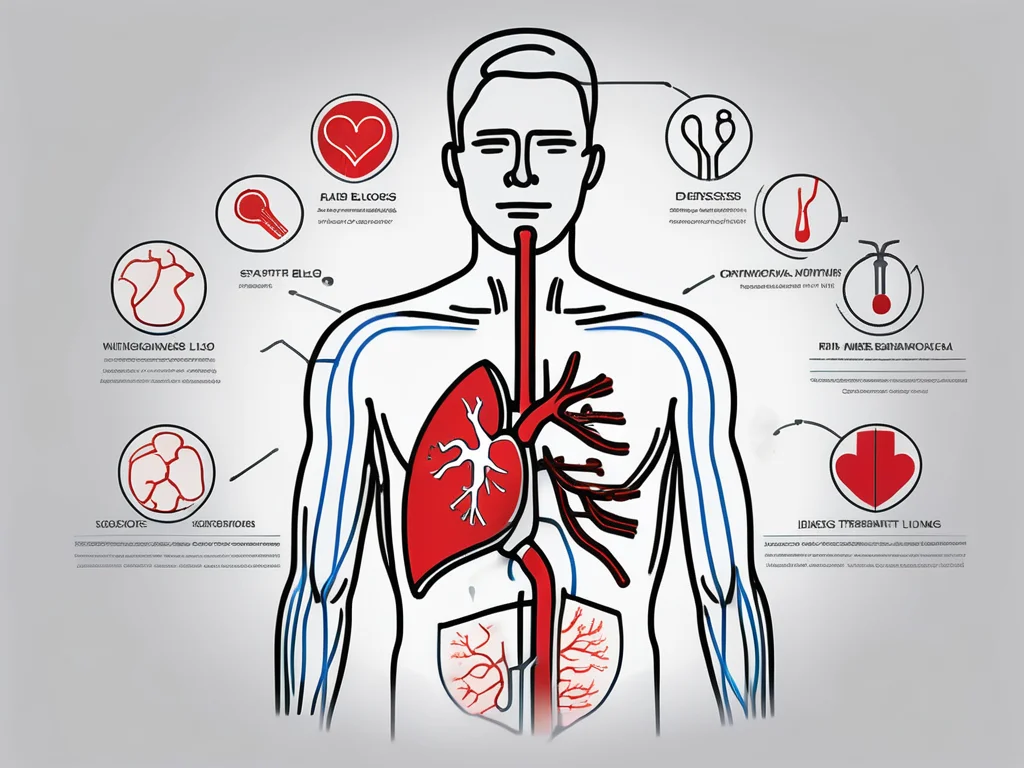Serious health conditions can be associated with chest pain. One particular type of chest pain that individuals may experience is right-side chest pain. This article aims to provide a comprehensive understanding of the causes, symptoms, and treatment options available for right-side chest pain.
An Overview of Right-Side Chest Pain
Right-side chest pain refers to any discomfort or pain experienced in the right side of the chest. Chest pain can come from heart, lungs, GI tract, muscles. To determine the underlying cause of right-side chest pain, a careful assessment is necessary.
When experiencing right-side chest pain, it is important to consider factors such as the onset of pain, any aggravating or alleviating factors, associated symptoms like shortness of breath or dizziness, and any relevant medical history. This detailed information can help healthcare providers narrow down the potential causes and provide appropriate treatment.
What is Right-Side Chest Pain?
Right-side chest pain causes sensations of aching, sharpness, or squeezing on the right side of the chest. This pain may radiate to the arms, back, neck, or jaw, depending on the cause. It is crucial not to ignore any chest pain, as it could be an indicator of a potentially life-threatening condition.
Conditions such as pneumonia, pleurisy, gallbladder issues, or muscle strain can cause chest pain on the right side. Distinguishing between causes needs physical exam, imaging, and lab tests for an accurate diagnosis.
The Importance of Understanding Chest Pain
It is crucial to comprehend chest pain nature, especially if it happens on the right side of the chest. Prompt recognition and appropriate management of the underlying cause are crucial for ensuring optimal outcomes and preventing potential complications.
Patients with right-side chest pain should seek medical attention promptly to receive a comprehensive evaluation. Depending on the suspected cause, treatment may involve medications, lifestyle modifications, physical therapy, or in severe cases, surgical intervention. When experiencing chest pain, always prioritize caution and seek guidance from a healthcare professional for proper evaluation and treatment.
Common Causes of Right-Side Chest Pain
Various causes, including cardiovascular, respiratory, gastrointestinal, and musculoskeletal conditions, can result in right-side chest pain.
Identifying reasons for chest pain is crucial for treatment decisions.
Cardiovascular Causes
The heart is a vital organ responsible for pumping blood throughout the body. Any problem affecting the heart can manifest as right-side chest pain. Cardiovascular issues like heart attack can cause right-side chest pain.
It is essential to monitor cardiovascular health through regular check-ups, maintaining a healthy lifestyle, and promptly addressing any symptoms that may indicate heart-related issues.
Respiratory Causes
Respiratory conditions can also lead to right-side chest pain. These may include conditions such as pneumonia, pleurisy (inflammation of the lung lining), lung cancer, or a collapsed lung (pneumothorax).
Healthcare professionals should evaluate and treat any respiratory issues to ensure proper respiratory function and prevent complications for overall health.
Gastrointestinal Causes
Several gastrointestinal disorders can cause right-side chest pain. These may include gastroesophageal reflux disease (GERD), gallbladder disease, peptic ulcer disease, or liver inflammation (hepatitis).
Maintaining a balanced diet, staying hydrated, and seeking medical advice for gastrointestinal symptoms can help in managing and alleviating right-side chest pain caused by gastrointestinal issues.
Musculoskeletal Causes
Musculoskeletal causes can also attribute to right-side chest pain. Strained or injured muscles in the chest wall, rib fractures, or conditions such as costochondritis (inflammation of the rib cage) and fibromyalgia can lead to this type of pain.
Practicing good posture, engaging in regular exercise, and seeking physical therapy for musculoskeletal conditions can aid in reducing right-side chest pain associated with musculoskeletal issues.
Symptoms to Look Out For
Recognizing the accompanying symptoms associated with right-side chest pain can aid in determining the underlying cause. Different causes may present with various signs and symptoms.
When experiencing right-side chest pain, it is crucial to pay attention to any additional symptoms that may accompany it. These symptoms can provide valuable clues to help healthcare providers diagnose the root cause of the pain and determine the most appropriate treatment plan.
Associated Symptoms with Cardiovascular Causes
Cardiovascular causes of right-side chest pain may be accompanied by symptoms such as shortness of breath, dizziness, sweating, nausea, or radiating pain to the left arm or jaw.
It is important to note that cardiovascular symptoms accompanying right-side chest pain should never be ignored, as they could indicate a potentially serious heart condition that requires immediate medical attention. Any chest pain associated with these symptoms should prompt a visit to a healthcare provider or emergency room for further evaluation.
Signs Related to Respiratory Causes
If right-side chest pain stems from a respiratory condition, symptoms like cough, difficulty breathing, fever, or sputum production may be present. Additionally, chest pain worsened by deep breathing or coughing might also indicate a respiratory cause.
Respiratory causes of chest pain can range from mild conditions such as bronchitis to more severe issues like pneumonia or pulmonary embolism. Seeking medical advice is crucial to properly diagnose and treat the underlying respiratory condition causing the chest pain.
Symptoms Linked to Gastrointestinal Causes
Right-side chest pain with gastrointestinal causes can present symptoms such as heartburn, abdominal pain, nausea, vomiting, or changes in bowel habits.
Individuals experiencing right-side chest pain along with gastrointestinal symptoms should consult a healthcare provider to rule out conditions such as acid reflux, gastritis, or gallbladder issues. Proper diagnosis and treatment can help alleviate the discomfort and address the underlying gastrointestinal problem.
Indicators of Musculoskeletal Causes
Right-side chest pain caused by musculoskeletal issues may be identified by tenderness when the chest wall is palpated, pain worsened by movement or deep breathing, and muscle stiffness.
When musculoskeletal issues are the culprit behind right-side chest pain, activities that involve the chest muscles may worsen the discomfort. Seeking guidance from a healthcare provider or physical therapist can help in managing musculoskeletal chest pain through targeted exercises and therapies.
Diagnosing Right-Side Chest Pain
Diagnosing the underlying cause of right-side chest pain involves comprehensive assessment and diagnostic procedures.
Right-side chest pain can be caused by a variety of factors, ranging from musculoskeletal issues to more serious conditions affecting the heart, lungs, or gastrointestinal system. Understanding the specific cause of the pain is crucial in determining the appropriate treatment and management plan.
Initial Assessment and Physical Examination
The healthcare provider will conduct an initial assessment, including a detailed medical history and physical examination. The examination may involve palpating the chest, listening to lung sounds, assessing heart sounds, and checking for any signs of inflammation or injury.
During the physical examination, the healthcare provider will also assess for any signs of tenderness, swelling, or abnormalities in the chest area. It is important to provide detailed information about the onset, duration, and characteristics of the chest pain to assist in the diagnostic process.
Laboratory Tests and Imaging
Additional laboratory tests, such as blood tests or electrocardiography (ECG), may be ordered to evaluate cardiac function and rule out any heart-related conditions. Imaging studies, such as chest X-rays, computed tomography (CT) scans, or echocardiograms, might be performed to assess the internal structures of the chest and detect any abnormalities.
These diagnostic tests can provide valuable information about the health of the heart, lungs, and surrounding structures. They can help identify potential causes of right-side chest pain, such as pneumonia, pleurisy, pericarditis, or even issues related to the esophagus or stomach.
Specialist Referrals and Further Testing
In some cases, when the exact cause remains unclear, the healthcare provider may refer the individual to a specialist, such as a cardiologist, pulmonologist, or gastroenterologist, for further evaluation and specialized testing. These specialists can provide expertise in their respective fields to aid in accurate diagnosis.
Specialized testing may include procedures like stress tests, bronchoscopy, or endoscopy to further investigate the underlying cause of the right-side chest pain. Collaboration between different medical specialties is often necessary to ensure a comprehensive and thorough evaluation of the patient’s condition.
Treatment Options
The treatment for right-side chest pain varies depending on the underlying cause. Once a diagnosis is made, healthcare professionals will recommend appropriate treatment options tailored to the individual’s specific condition.
In cases where right-side chest pain is caused by musculoskeletal issues such as muscle strain or costochondritis, treatment may involve rest, gentle stretching exercises, and over-the-counter pain medications. Physical therapy and heat or ice therapy may also be recommended to help alleviate discomfort and promote healing.
For conditions like pleurisy or pneumonia that affect the lungs and respiratory system, treatment may include antibiotics, anti-inflammatory medications, and in severe cases, hospitalization for close monitoring and intravenous therapy. It is crucial for individuals experiencing persistent or worsening chest pain to seek medical attention promptly to determine the underlying cause and receive appropriate treatment.
When to Seek Medical Attention
It is crucial to seek prompt medical attention if you experience right-side chest pain, especially if it is severe, persistent, or accompanied by other concerning symptoms. Only a healthcare professional can accurately diagnose the cause of the chest pain and provide appropriate guidance and treatment.
In conclusion, right-side chest pain can be caused by various factors, encompassing cardiovascular, respiratory, gastrointestinal, and musculoskeletal causes. Understanding the nature of chest pain and recognizing accompanying symptoms are crucial for accurate diagnosis and proper management. Seeking medical attention promptly is essential to ensure the best possible outcomes and prevent potential complications.



